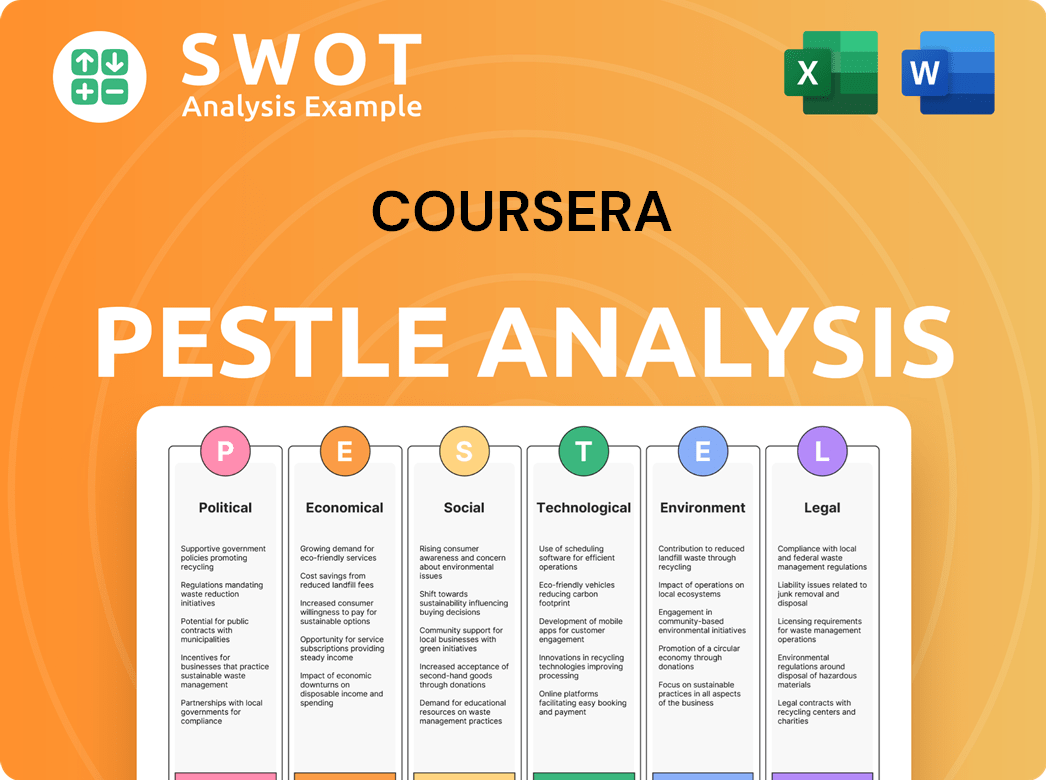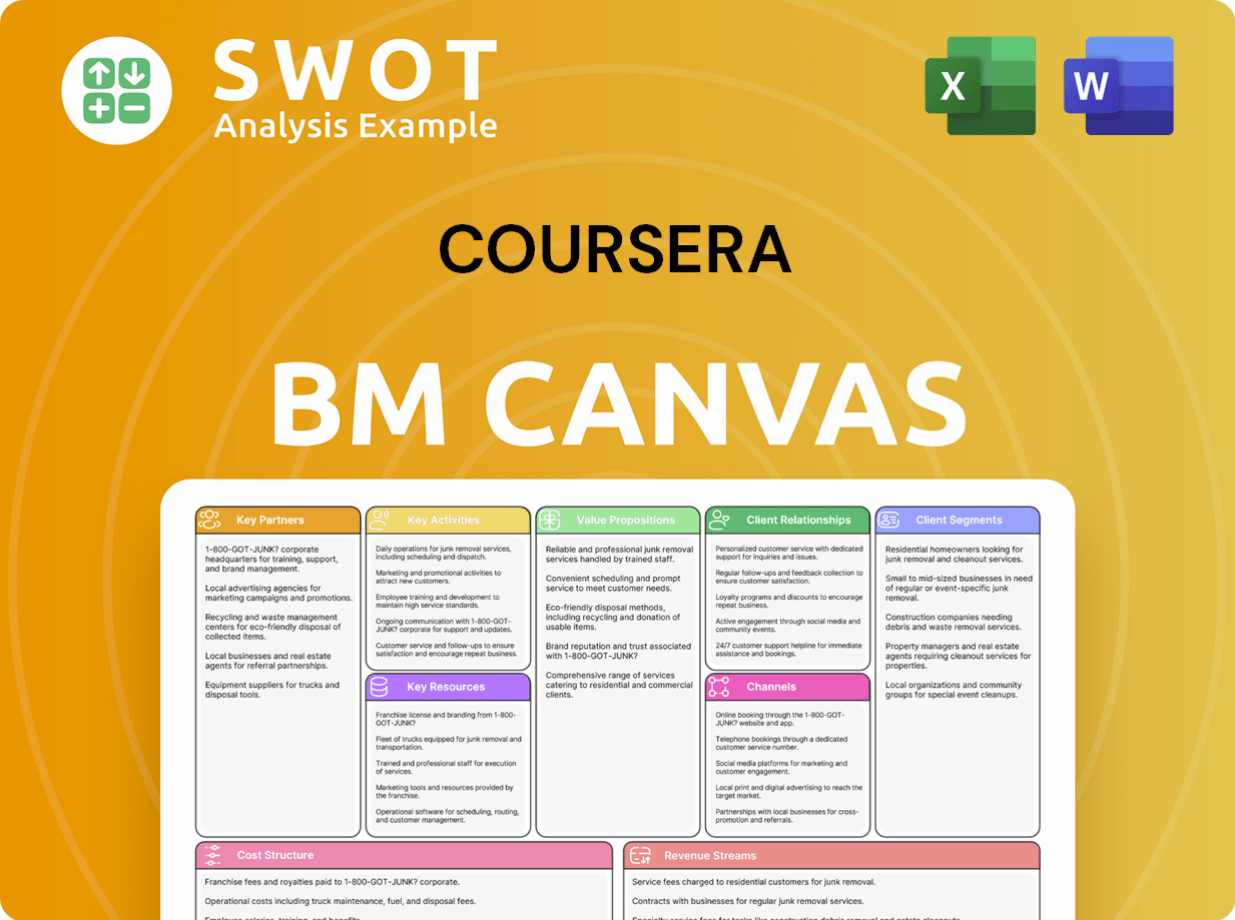Coursera Bundle
How Does Coursera Thrive in the E-Learning Arena?
Coursera, a titan in the online learning sphere, continues to reshape education globally. With a robust 2024 revenue of $694.7 million and its first year of positive Adjusted EBITDA, the company showcases impressive financial acumen. Serving over 168 million learners worldwide, Coursera has solidified its position as a leading provider of Coursera SWOT Analysis, courses, degrees, and professional certificates.

This deep dive explores how Coursera works, from its operational strategies to its revenue models. We'll examine its response to market shifts, especially in workforce skills and AI, and its strategic adaptations. Understanding the Coursera platform is key for anyone looking to navigate the evolving landscape of online learning, including details of Coursera courses review, Coursera subscription cost and benefits.
What Are the Key Operations Driving Coursera’s Success?
The core of how Coursera works revolves around providing accessible online learning experiences. It acts as a bridge, connecting individuals with educational content from top universities and industry leaders. This platform offers a wide array of options, from individual courses to full degree programs, catering to diverse learning needs.
Coursera's value proposition centers on offering high-quality, accredited online education. It empowers learners to acquire job-relevant skills and recognized credentials. This approach distinguishes it from competitors by providing a blend of academic rigor and industry relevance.
The Coursera platform facilitates content delivery, learner engagement, and assessment. It partners with over 350 universities and industry leaders globally to source its diverse content catalog. The company's technology development includes advanced tools such as adaptive learning algorithms and AI-powered features like Coursera Coach, which saw 1.7 million users exchange over 21 million messages in 2024, enhancing personalized learning experiences.
Coursera provides individual courses, Specializations (a series of related courses), Professional Certificates, and full degree programs. These offerings cater to a broad audience, from individual learners to businesses seeking to upskill their workforce. The platform's diverse content ensures there's something for everyone, whether for career advancement or personal development.
The platform collaborates with over 350 universities and industry leaders. These partnerships are crucial for delivering accredited content and recognized credentials. Companies like Google, IBM, and Microsoft contribute to professional certificates, making the platform a valuable resource for skills relevant to today's job market.
Coursera's operational processes are built on a robust digital platform that facilitates content delivery, learner engagement, and assessment. The supply chain involves managing relationships with content partners and ensuring the seamless integration and delivery of educational materials. Its distribution network is inherently global, reaching learners in over 230 countries and territories.
Customers benefit from access to job-relevant skills, recognized credentials, and flexible learning pathways. The platform differentiates itself by offering a diverse range of high-quality, accredited online education options. This makes it a go-to resource for those seeking to enhance their skills and advance their careers. To learn more about who uses the platform, check out the Target Market of Coursera.
Coursera's platform includes various features designed to enhance the learning experience. These include a user-friendly interface, mobile accessibility, and community forums. The platform also offers personalized learning paths and AI-powered tools to support learners.
- Adaptive learning algorithms to tailor content to individual needs.
- AI-powered features like Coursera Coach for personalized support.
- A global reach, serving learners in over 230 countries and territories.
- Partnerships with top universities and industry leaders for accredited content.
Coursera SWOT Analysis
- Complete SWOT Breakdown
- Fully Customizable
- Editable in Excel & Word
- Professional Formatting
- Investor-Ready Format

How Does Coursera Make Money?
The Coursera platform generates revenue through a diversified monetization strategy, primarily focusing on its Consumer and Enterprise segments. This approach has allowed the company to establish itself as a key player in the online learning market. Understanding how Coursera works and its revenue model is crucial for anyone interested in online education and the company's growth trajectory.
For the full year 2024, Coursera's total revenue reached $694.7 million, reflecting a 9% increase from the previous year. In Q1 2025, the company reported revenue of $179.3 million, a 6% year-over-year increase. This growth demonstrates the effectiveness of its monetization strategies and the increasing demand for online courses.
The major revenue streams include Consumer, Enterprise, and Degrees, with the latter being integrated into the Consumer segment starting in Q1 2025. These segments cater to individual learners, businesses, and academic institutions, providing a wide array of online courses and learning solutions. If you're interested in how Coursera compares to other platforms, you might find insights in the Competitors Landscape of Coursera.
The Consumer segment, which now includes Degrees, primarily earns revenue from individual course purchases, Specializations, Professional Certificates, and the Coursera Plus subscription. This segment is a significant contributor to the overall revenue, reflecting the popularity of online learning among individuals seeking to enhance their skills and knowledge.
- In 2024, consumer revenue was $398.1 million.
- For Q4 2024, consumer revenue was $101.7 million, up 5% from the prior year, driven by Coursera Plus.
- In Q1 2025, Consumer revenue was $117.6 million, a 5% increase year-over-year.
- Coursera Plus, a subscription offering unlimited access to a large portion of Coursera's catalog, is a significant contributor, with monthly plans starting at $59/month and annual plans at $399/year.
The Enterprise segment focuses on providing learning solutions to businesses, governments, and academic institutions through offerings like Coursera for Business, Coursera for Government, and Coursera for Campus. This segment leverages partnerships to offer tailored learning programs for workforce development and upskilling initiatives, making it a crucial part of the company's growth strategy.
- Enterprise revenue was $238.9 million in 2024.
- In Q4 2024, Enterprise revenue was $62.3 million, up 7% from a year ago, with the total number of paid enterprise customers increasing by 18% to 1,612.
- For Q1 2025, Enterprise revenue reached $61.7 million, a 7% increase year-over-year.
Historically a separate segment, Degrees revenue was $57.7 million in 2024. In Q4 2024, Degrees revenue was $15.2 million, up 14% from a year ago. However, beginning in Q1 2025, Coursera has simplified its business model, integrating the Degrees segment into the Consumer segment. This strategic shift reflects a focus on serving learners across a broad set of offerings within the Consumer segment.
Coursera employs a freemium model, offering some content for free to attract learners who may then convert to paid subscriptions or course purchases. Innovative strategies also include tiered pricing for different offerings and cross-selling between its various learning products. The company has also been investing in 'Coursera produced content,' particularly Professional Certificates, which gives them better control and is considered favorable.
- Coursera offers a wide variety of online courses, including MOOC options.
- The platform provides various options for learners, including Coursera free courses and paid subscriptions like Coursera Plus subscription benefits.
- For those considering higher education, Coursera degree programs are available.
- Understanding the Coursera certificate cost and exploring options like Coursera financial aid can make education more accessible.
- Reviews and comparisons, such as Coursera vs edX, are helpful for prospective students.
Coursera PESTLE Analysis
- Covers All 6 PESTLE Categories
- No Research Needed – Save Hours of Work
- Built by Experts, Trusted by Consultants
- Instant Download, Ready to Use
- 100% Editable, Fully Customizable

Which Strategic Decisions Have Shaped Coursera’s Business Model?
The evolution of Coursera has been marked by significant milestones and strategic shifts. Launched in 2012 by Andrew Ng and Daphne Koller, the platform aimed to make world-class education accessible to everyone. Strategic moves like the introduction of 'Coursera for Government' in 2017 and 'Coursera for Campus' in 2020 expanded its reach beyond individual learners.
A key partnership with Google in 2018 resulted in the Google IT Support Professional Certificate, highlighting Coursera's focus on job-relevant skills. The platform has consistently expanded its content, adding nearly 40 new entry-level Professional Certificates and over 450 generative AI courses in 2024. New offerings from industry leaders such as Dell Technologies, Microsoft, Xbox, DeepLearning.AI, Google, and IBM have further enriched its catalog.
Operational challenges include retaining consumer segments, which could impact long-term revenue stability. In response, the company is focusing on AI-powered tools for educators and personalized recommendations for learners. A recent strategic move in Q1 2025 was simplifying its business model by integrating the Degrees segment into the Consumer segment. Coursera for Campus is a primary growth engine for 2025, expected to deliver the highest growth among enterprise offerings. Increased investment in proprietary content production, particularly Professional Certificates, is also planned for 2025.
The launch in 2012 by Stanford professors Andrew Ng and Daphne Koller was a pivotal moment. The establishment of 'Coursera for Government' in 2017 and 'Coursera for Campus' in 2020 expanded its reach. The 2018 partnership with Google led to the launch of the Google IT Support Professional Certificate.
Emphasis on AI-powered capabilities and personalized learning. Simplification of the business model in Q1 2025, integrating the Degrees segment into the Consumer segment. Increased investment in proprietary content, particularly Professional Certificates, is a key focus for 2025.
Strong brand built on partnerships with over 350 leading universities and industry leaders. Technology leadership with AI-powered learning tools and adaptive algorithms. A vast learner base of 175 million registered learners as of Q1 2025 attracts more content partners.
Rapid expansion of AI-driven courses, with 12 AI enrollments per minute in Q1 2025, up from 1 per minute in 2023. This growth underscores the platform's ability to adapt to new trends in the online learning space. The platform has seen significant growth, as detailed in this article about Growth Strategy of Coursera.
Coursera's success stems from its strong brand, extensive content, and technological advancements. Its partnerships with top universities and industry leaders provide a wide array of courses. The platform's AI-driven tools enhance the learning experience.
- Partnerships with over 350 universities and industry leaders.
- A broad catalog of accredited content.
- AI-powered learning tools like Coursera Coach.
- A diverse learner base of 175 million registered learners.
Coursera Business Model Canvas
- Complete 9-Block Business Model Canvas
- Effortlessly Communicate Your Business Strategy
- Investor-Ready BMC Format
- 100% Editable and Customizable
- Clear and Structured Layout

How Is Coursera Positioning Itself for Continued Success?
The company holds a leading position in the online learning industry. As of Q1 2025, the platform boasts a substantial learner base, with approximately 175 million registered learners. The company's extensive network of over 350 university and industry partners contributes to its broad content catalog. Its global reach extends to over 230 countries and territories, attracting learners at a low cost and serving diverse educational and career goals.
However, the company faces several risks. These include potential challenges within its consumer segment, as noted in recent earnings calls. Macroeconomic uncertainties could impact enterprise spending on learning solutions. The rapidly evolving landscape of AI and its impact on skill demands also presents both an opportunity and a risk, requiring continuous adaptation and innovation in course offerings.
The company is a major player in the online learning market. Its vast content library and partnerships with top universities and industry leaders enhance its credibility and appeal. The platform's focus on job-relevant skills and accredited content drives positive career outcomes, fostering customer loyalty.
The company faces retention challenges within its consumer segment. Macroeconomic factors and competition from other EdTech players pose risks. The rapid advancements in AI and its impact on skill requirements necessitate continuous adaptation of course offerings.
The company is focused on sustainable revenue generation and expansion. The company's strategic initiatives include a 'learner-first' philosophy and platform unification. They are investing in content, especially Professional Certificates, and prioritizing Coursera for Campus.
The company updated its full-year 2025 revenue expectations to a midpoint of $725 million, projecting a 4-5% year-over-year growth. They aim for an annual Adjusted EBITDA Margin improvement of 100 basis points to 7.0% for the full year 2025. The company seeks to solidify its position as a platform for skills transformation and the future of work.
The company's strategy emphasizes product innovation, content expansion, and enhanced go-to-market strategies. This includes a focus on Professional Certificates and Coursera for Campus to drive growth. The company is also focused on improving profitability and expanding its market reach.
- Prioritizing 'Coursera for Campus' for enterprise growth.
- Increasing investment in 'Coursera produced content,' particularly Professional Certificates.
- Aiming for an annual Adjusted EBITDA Margin improvement of 100 basis points to 7.0% for the full year 2025.
- Focusing on product innovation and enhanced go-to-market strategies.
The company's commitment to product innovation and content expansion is key to its future success. You can learn more about the Marketing Strategy of Coursera. This approach, combined with a focus on enhancing go-to-market strategies, positions the company to maintain its leadership in the online learning industry. The company's strategic focus on the 'learner-first' approach and platform unification will be critical in achieving its financial targets and solidifying its role in the future of work. Continuous adaptation to the rapidly changing technological landscape, particularly in AI, will also be crucial for long-term sustainability and growth.
Coursera Porter's Five Forces Analysis
- Covers All 5 Competitive Forces in Detail
- Structured for Consultants, Students, and Founders
- 100% Editable in Microsoft Word & Excel
- Instant Digital Download – Use Immediately
- Compatible with Mac & PC – Fully Unlocked

Related Blogs
- What are Mission Vision & Core Values of Coursera Company?
- What is Competitive Landscape of Coursera Company?
- What is Growth Strategy and Future Prospects of Coursera Company?
- What is Sales and Marketing Strategy of Coursera Company?
- What is Brief History of Coursera Company?
- Who Owns Coursera Company?
- What is Customer Demographics and Target Market of Coursera Company?
Disclaimer
All information, articles, and product details provided on this website are for general informational and educational purposes only. We do not claim any ownership over, nor do we intend to infringe upon, any trademarks, copyrights, logos, brand names, or other intellectual property mentioned or depicted on this site. Such intellectual property remains the property of its respective owners, and any references here are made solely for identification or informational purposes, without implying any affiliation, endorsement, or partnership.
We make no representations or warranties, express or implied, regarding the accuracy, completeness, or suitability of any content or products presented. Nothing on this website should be construed as legal, tax, investment, financial, medical, or other professional advice. In addition, no part of this site—including articles or product references—constitutes a solicitation, recommendation, endorsement, advertisement, or offer to buy or sell any securities, franchises, or other financial instruments, particularly in jurisdictions where such activity would be unlawful.
All content is of a general nature and may not address the specific circumstances of any individual or entity. It is not a substitute for professional advice or services. Any actions you take based on the information provided here are strictly at your own risk. You accept full responsibility for any decisions or outcomes arising from your use of this website and agree to release us from any liability in connection with your use of, or reliance upon, the content or products found herein.